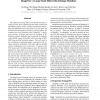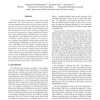CVPR
2009
IEEE
14 years 3 months ago
2009
IEEE
In this paper we address the problem of recognizing moving objects in videos by utilizing synthetic 3D models. We use only the silhouette space of the synthetic models making thus...
CVPR
2009
IEEE
14 years 3 months ago
2009
IEEE
Ranking large scale image and video collections usually expects higher accuracy on top ranked data, while tolerates lower accuracy on bottom ranked ones. In view of this, we propo...
CVPR
2009
IEEE
14 years 3 months ago
2009
IEEE
Boosted by the Middlebury challenge, the precision of dense multi-view stereovision methods has increased drastically in the past few years. Yet, most methods, although they perfo...
CVPR
2009
IEEE
14 years 3 months ago
2009
IEEE
We propose a learning-based hierarchical approach of multi-target tracking from a single camera by progressively associating detection responses into longer and longer track fragm...
CVPR
2009
IEEE
14 years 3 months ago
2009
IEEE
CVPR
2009
IEEE
14 years 3 months ago
2009
IEEE
One promising approach to remove motion deblurring is to recover one clear image using an image pair. Existing dual-image methods require an accurate image alignment between the i...
CVPR
2009
IEEE
14 years 3 months ago
2009
IEEE
We show that histograms of keypoint descriptor distances can make useful features for visual recognition. Descriptor distances are often exhaustively computed between sets of keyp...
CVPR
2009
IEEE
14 years 3 months ago
2009
IEEE
The explosion of image data on the Internet has the potential to foster more sophisticated and robust models and algorithms to index, retrieve, organize and interact with images a...
CVPR
2009
IEEE
14 years 3 months ago
2009
IEEE
Face detection plays an important role in many vision applications. Since Viola and Jones [1] proposed the first real-time AdaBoost based object detection system, much effort has ...
CVPR
2009
IEEE
14 years 3 months ago
2009
IEEE
Visual tracking is a key component in many computer vision applications. Linear subspace techniques (e.g. eigentracking) are one of the most popular approaches to align templates ...


